 The term "Spatial relations" does not refer to aunts and uncles from Mars. Rather, someone who is good at visualizing how things fit together is said to be good with "spatial relations". This was always a talent of mine. It was particularly helpful on IQ tests, in which one is often asked to match images of solid objects seen in different orientations. It's a good talent for engineers, particularly mechanical engineers. I don't think it helps you quite as much in my field, electrical engineering. As a child, I used to sit down with a pencil and ruler, and draw things like this: 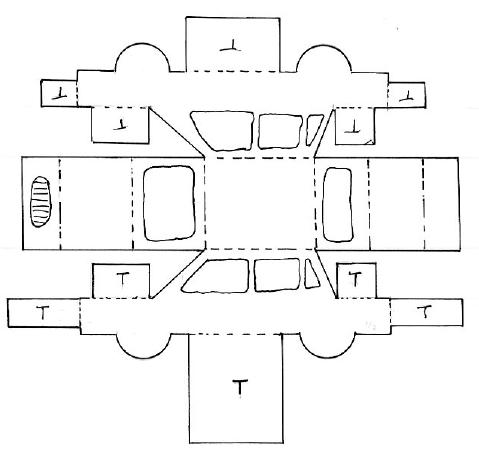 Then I'd cut it out with scissors, and sometimes an exacto knife: 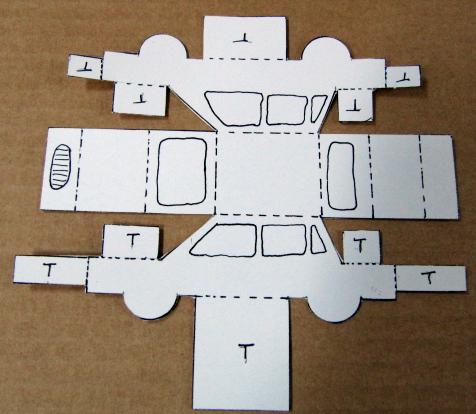 Finally, I'd fold on the dotted lines, and hold it together with tape or glue on the inside (occasionally, I included tabs that went into slots): 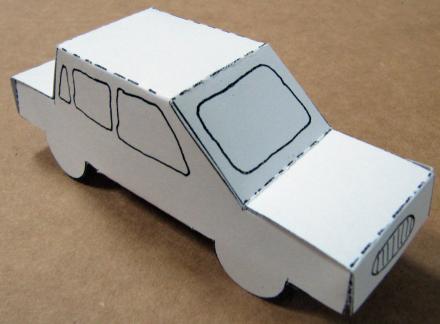 I created cars, guns, and all sorts of toys. The fun was in visualizing how the object I wanted to achieve could be created from a single flat sheet of paper. I measured with great care, and seldom ran into problems when folding. Not long ago, I created a bunch of "cameras" out of folded paper, for Margie to use for instruction on perspective in a basic drawing class. A funny thing is that although I'm quite good at reading maps, I often have problems making turn decisions at intersections. There's a particular intersection in the town of Wayland called "Five Paths" (I don't know why, since only four roads come into it). Every time I drive into it from the north, which I do often, I have difficulty visualizing the outcome of the two alternatives. I have not infrequently gone the wrong way. Margie is rather amused by this.
This is a pack made for travelers, which is held on by a slash-resistant belt (it has steel cables in it). Although at home I've been wearing the phone on a kind of belt holster, I'd rather get it into the fanny pack, out of sight and out of reach, when away from home. But I don't want it to just knock around in the pack, rubbing against my European cell phone and my camera. So I built a holder for it out of foam rubber, with a slot for the phone. For material, I cut up three small circular foam rubber bulletin boards, 10 mm. thick (3/8 inches), purchased at an art supplies store (see some of the pieces to the left). To protect the phone, particularly the camera lens on the back, I lined the slot with a soft fabric. The fabric started out as a cleaning cloth that came with some eyeglasses I bought from Costco. Here are the steps. First, the holder is a sandwich of three layers, held together with double-sided foam tape: 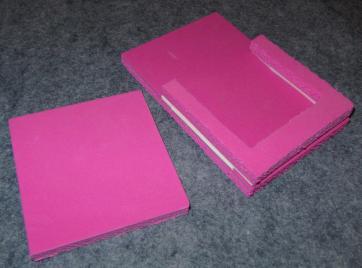 Next, I laid out the liner, to be cut and folded: 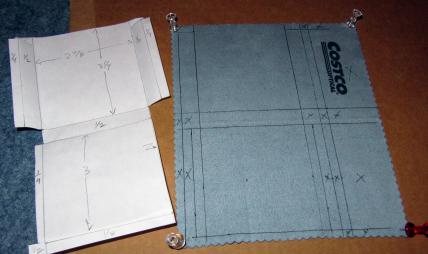 The fabric was pinned to a piece of cardboard, and marked on the reverse side.
But I didn't use the paper as a "pattern", as would be done by a dressmaker. Given the small size of the product, I thought this would introduce errors. Instead, after verifying that the paper pattern fit when folded into the holder, I redrew the pattern directly on the fabric. You can see the fabric after cutting to the right. Actually, I was glad that I did try it out first in paper. The cutting errors were actually in the foam rubber, since cutting with a heavy razor blade and assembling the holder with double-sided tape was a bit of a sloppy process. The interior slot was about an eighth of an inch narrower than I had designed it. I discovered this while fitting the paper pattern into the slot, and adjusted the pattern on the cloth accordingly. Next, the cloth was folded into the slot in the holder. A thinner double-sided tape was used to hold the liner against the foam rubber. The flap of liner lying towards the upper left in the left-hand photo below was later folded over to produce the front surface of the liner. Its edges were trapped between the sides of the holder and the front face, stretching it across the front face, which has yet to be added in the left-hand photo. The photo to the right below shows the final result, with the phone in the holder. 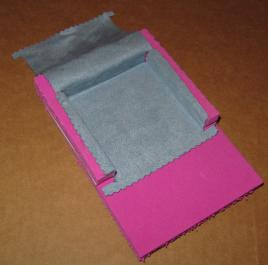 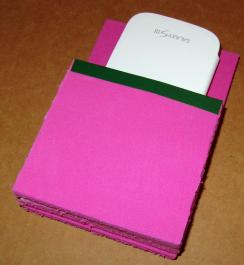 It's still fun to do. Maybe that's why I became an engineer.   |
 Here's a recent project: a holder for my new Samsung Galaxy S III smart phone (see my recent entry
Here's a recent project: a holder for my new Samsung Galaxy S III smart phone (see my recent entry 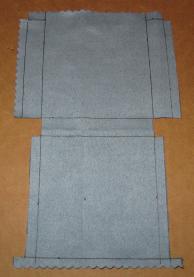 Note above that I made a version of the liner in paper, so as to catch any errors before actually cutting the fabric. I didn't have any excess fabric, and didn't want to make a mistake.
Note above that I made a version of the liner in paper, so as to catch any errors before actually cutting the fabric. I didn't have any excess fabric, and didn't want to make a mistake.